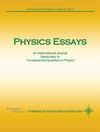The case against gravity
IF 0.5
Q4 PHYSICS, MULTIDISCIPLINARY
引用次数: 0
Abstract
The myth of this “quasi-magical” gravity and its “effect at a distance” endures, and our brains remain “hardwired” to this perception. However, “quantum gravity” is increasingly closer to nullifying the importance of this mysterious force by treating it with the outmost contempt as a “negligible force.” We concur with this interpretation, and more: We claim in this article that not only is gravity negligible but also explain how it can be completely eliminated as one of four fundamental forces of the universe. This article is, in fact, a continuation, a widening, and a confirmation of an article I wrote in 1993, titled “The proportional expansion of each and every celestial body as the cause of gravitation” [Phys. Essays 6, 473 (1993)]. There, I had argued that not only is empty space expanding in the classically understood sense, but that all celestial bodies are also subject to an accelerated expansion. According to Einstein’s principle of equivalence, acceleration generates an opposite, “fictitious” force that is perceived as gravity. I had concluded there that “in terms of quantum mechanics, in this interpretation, the very existence of the predicted ‘graviton’ becomes extremely questionable.” Thirty years have passed since then. And in spite of the development of the Large Hadron Collider and its impressive capabilities, the above claim has been confirmed, and the graviton has been quietly replaced by the Higgs boson in the nomenclature of the Standard Model of elementary particles. In this article, we revisit Galileo and Newton to show that the latter could not have arrived at any other conclusion than an “attractive” force of gravity. We also ask why Albert Einstein did not apply his own principle of equivalence to the Newtonian interpretation of gravity. At the same time, some very “peculiar” interpretations have arisen since my above-mentioned article from 1993. “Dark matter” and “dark energy,” both very speculative conceptualizations, have been forced upon us to explain two phenomena: The anomaly discovered in the speed of rotation of the galaxies, and the accelerated expansion of the universe, despite the potentially shrinking effect of gravity. Of all the positive advances in physics, the most fundamental is the genesis of “quantum gravity,” the tenets of which relegate gravity to the level of a “negligible” force. This is followed by the characterization of the Higgs boson, which has replaced the graviton in the Standard Model. This conceptually translates into the fact that the gravitational mass has possibly been replaced by the inertial mass of celestial bodies. The confirmation and measurements of the accelerated expansion of the universe, while there is still some controversies regarding the exact results of these measurements. Finally, the most important discovery in this regard was recently made in 2019, regarding the exceptionally high pressure inside protons and neutrons, (1035 Pa). This lends credence to the concept of the expansion of these subatomic particles. The multiplicity of these hadrons (3.26 × 1080) and their ubiquitous distribution in the baryonic matter of the entire universe explain its expansion. These hadrons are highly “diluted” in empty space but, on the contrary, are highly clustered and concentrated inside solid matter, where this explains the difference in density between these media and the massive dissimilarity in the magnitudes of their relative accelerated expansion. It also explains why what we call “gravity” is not an active force, but merely the consequence of the density-proportional accelerated radial expansion of each and every celestial body. As such, this baryonic expansion explains the expansion of the universe as a whole, and replaces gravity as a concept as well as its perceived effects. By dint of its ubiquitous nature, this notion of baryonic expansion provides a bridge between the microscopic and macroscopic universe. Quantum physics reconnects with general relativity in this formalism and clarifies the “what and how.”反对重力的理由
这种 "准神奇 "的引力及其 "远距离效应 "的神话依然存在,我们的大脑仍然 "硬连接 "着这种认知。然而,"量子引力 "越来越接近于抹杀这种神秘力量的重要性,将其蔑视为 "可忽略不计的力量"。我们同意这种解释,而且还不止于此:我们在这篇文章中声称,引力不仅可以忽略不计,而且还解释了它作为宇宙四种基本力之一是如何被完全消除的。事实上,这篇文章是我在 1993 年写的一篇文章的延续、扩展和确认,这篇文章的标题是 "每个天体的比例膨胀是引力的原因"[《物理论文》6,473(1993)]。在那篇文章中,我论证了不仅按照经典的理解,虚空在膨胀,而且所有天体也在加速膨胀。根据爱因斯坦的等效原理,加速度会产生一种相反的、"虚构的 "力,这种力被认为是万有引力。我曾在那里得出结论:"从量子力学的角度来看,在这种解释中,预言中的'引力子'的存在本身就变得极为可疑"。从那时起,30 年过去了。尽管大型强子对撞机的发展及其令人印象深刻的能力,上述说法还是得到了证实,在基本粒子标准模型的命名中,引力子已悄然被希格斯玻色子所取代。在这篇文章中,我们重温了伽利略和牛顿,以说明后者除了得出 "有吸引力 "的引力之外,不可能得出任何其他结论。我们还会问,为什么爱因斯坦没有将他自己的等效原理应用于牛顿对万有引力的解释?与此同时,自从我在 1993 年发表上述文章以来,又出现了一些非常 "奇特 "的解释。"暗物质 "和 "暗能量 "都是非常臆测的概念,却被强加给我们来解释两种现象:星系旋转速度的异常现象,以及宇宙加速膨胀,尽管引力的作用可能会缩小。在物理学取得的所有积极进展中,最根本的是 "量子引力 "的产生,其信条将引力降到了 "可忽略不计 "的程度。其次是希格斯玻色子的特征,它在标准模型中取代了引力子。从概念上讲,这意味着引力质量可能已被天体的惯性质量所取代。对宇宙加速膨胀的确认和测量,尽管对这些测量的确切结果仍存在一些争议。最后,这方面最重要的发现是最近在 2019 年取得的,关于质子和中子内部的超高压(1035 帕)。这为这些亚原子粒子膨胀的概念提供了依据。这些强子的多重性(3.26 × 1080)及其在整个宇宙重子物质中无处不在的分布解释了宇宙膨胀的原因。这些强子在虚空中被高度 "稀释",但相反,却在固体物质中高度聚集和集中,这就解释了这些介质之间的密度差异,以及它们相对加速膨胀的巨大差异。这也解释了为什么我们所说的 "引力 "并不是一种主动力,而只是每个天体按密度比例加速径向膨胀的结果。因此,重子膨胀解释了整个宇宙的膨胀,并取代了万有引力这一概念及其感知效果。由于重子膨胀无处不在,这一概念在微观和宏观宇宙之间架起了一座桥梁。量子物理学在这一形式主义中重新连接了广义相对论,并澄清了 "是什么和如何"。
本文章由计算机程序翻译,如有差异,请以英文原文为准。
求助全文
约1分钟内获得全文
求助全文
来源期刊

Physics Essays
PHYSICS, MULTIDISCIPLINARY-
自引率
83.30%
发文量
50
审稿时长
6-12 weeks
期刊介绍:
Physics Essays has been established as an international journal dedicated to theoretical and experimental aspects of fundamental problems in Physics and, generally, to the advancement of basic knowledge of Physics. The Journal’s mandate is to publish rigorous and methodological examinations of past, current, and advanced concepts, methods and results in physics research. Physics Essays dedicates itself to the publication of stimulating exploratory, and original papers in a variety of physics disciplines, such as spectroscopy, quantum mechanics, particle physics, electromagnetic theory, astrophysics, space physics, mathematical methods in physics, plasma physics, philosophical aspects of physics, chemical physics, and relativity.
 求助内容:
求助内容: 应助结果提醒方式:
应助结果提醒方式:


